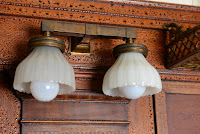 Parlor car 1799 is situated on a beautiful island beach on Puget Sound. The former Northern Pacific Railway Pullman-built wood car has been donated to the Northwest Railway Museum, and will be moved to the Train Shed Exhibit building. However, first it needs wheels!
Parlor car 1799 is situated on a beautiful island beach on Puget Sound. The former Northern Pacific Railway Pullman-built wood car has been donated to the Northwest Railway Museum, and will be moved to the Train Shed Exhibit building. However, first it needs wheels! Repurposed as a cottage in 1941, car 1799 has been supported with pilings for more than 77 years, and has retained all of its original elegance. And since the mid 1970s it has been housed inside a shelter. Last week, the shelter was disassembled, which was detailed in this blog. This week the next phase begins.
Repurposed as a cottage in 1941, car 1799 has been supported with pilings for more than 77 years, and has retained all of its original elegance. And since the mid 1970s it has been housed inside a shelter. Last week, the shelter was disassembled, which was detailed in this blog. This week the next phase begins. Nickel Bros specializes in transportation of homes and other structures, and they are a natural partner for a wood railroad car that lacks its truss rods. Nickel's team uses a set of hydraulic jacks to lift structures. They assemble a steel frame under and beside the building, and then place wheel dollies under the completed assembly.
Nickel Bros specializes in transportation of homes and other structures, and they are a natural partner for a wood railroad car that lacks its truss rods. Nickel's team uses a set of hydraulic jacks to lift structures. They assemble a steel frame under and beside the building, and then place wheel dollies under the completed assembly. The 1799 is particularly challenging because it has original structure in the car sides that could be easily damaged if jacked carelessly. Furthermore, the car weighs 80,000 pounds and has to be jacked evenly to avoid the potential for broken windows.
The 1799 is particularly challenging because it has original structure in the car sides that could be easily damaged if jacked carelessly. Furthermore, the car weighs 80,000 pounds and has to be jacked evenly to avoid the potential for broken windows.Nickel's solution includes two monstrous H beams that are designed to evenly support the entire car. Smaller beams extend from one side to the other perpendicular to the large beams. They directly bear on the bottom of the car and simultaneously pickup the side, intermediate and center sills.
 The jacking began quickly and uneventfully; there were no unusual sounds or movement. The frame had enough integrity that it was self-supporting for short periods of time as the jacks caught up. This is truly a testament to the car builders at Pullman, Illinois.
The jacking began quickly and uneventfully; there were no unusual sounds or movement. The frame had enough integrity that it was self-supporting for short periods of time as the jacks caught up. This is truly a testament to the car builders at Pullman, Illinois. Once the car was jacked up sufficiently, the wheel dollies were hoisted into place. A double set of wheels was installed to spread the mass over the 14 feet of width. These rubber-tired dollies have independent steer and adjustable height, both valuable features in avoiding complication on a difficult site.
Once the car was jacked up sufficiently, the wheel dollies were hoisted into place. A double set of wheels was installed to spread the mass over the 14 feet of width. These rubber-tired dollies have independent steer and adjustable height, both valuable features in avoiding complication on a difficult site.The process of moving car 1799 to the Museum is an exercise in careful planning. Now through May 9 you can schedule support for this project through the Seattle Foundation's Give Big event.












